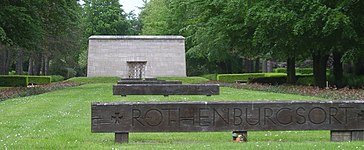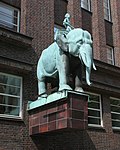Ludwig Kunstmann
Ludwig Kunstmann (born December 9, 1877 in Regensburg , † March 27, 1961 in Hamburg ) was a German sculptor .
Life
Kunstmann did an apprenticeship as a wood and stone sculptor in Regensburg from 1890 to 1894 and studied at the Stuttgart Art Academy . After extensive study trips through Germany and Northern Europe, he settled in Hamburg in 1910. There he became one of the most successful artists in the 1920s, which shows a large number of architectural sculptures. Kunstmann was one of the founding members of the Hamburg Secession (1919), but resigned and joined the Hamburg artists as early as 1920 after internal disputes together with other colleagues . He was also a member of the Hamburg Artists' Association from 1832 .
Ludwig Kunstmann died in Hamburg in 1961 and was buried in the Ohlsdorf cemetery west of Waldstrasse . The grave was dissolved after the rest period had expired.
plant
- around 1915 (?): six medallions with gilded ship motifs on the balcony railing on the 2nd floor of the commercial building in Hamburg (architect: Fritz Schumacher ) - unfortunately painted over white.
- 1920 ff: Sculpture work on the first renovation / extension of the administration building of the D. H. V. at Holstenwall in Hamburg (today's Brahms office ; see also second extension: around 1931, architects also Schkopp / Vortmann). The numerous figures at the main entrance have not been preserved. Otherwise only partially preserved, including donkey trough above the former side entrance.
- around 1922: Horse sculpture at Thaliahof , Gerhart-Hauptmann-Platz (former horse market ) in Hamburg (architects: Hans and Oskar Gerson )
- 1922/1923: Sculptural work on the warrior memorial in the churchyard in Rellingen (architect: Hermann Höger and employee Hopp)
- around 1924: Sculptures at the Ballin House in Hamburg (Architects: Hans and Oskar Gerson) (Sculptures destroyed, replaced in 1996/1997 by sculptures by Lothar Fischer )
- around 1925: Reliefs ( care for young people and care for old age ) at the entrance of the AOK building in Hamburg- Borgfelde (architects: Hermann Distel and August Grubitz)
- 1925/1927: As an external artist, sculptural and fine ceramic work for Kieler Kunst-Keramik AG : large-scale sculpture "Seemann" at the "Kurgartenhaus" in Travemünde on the corner of Kurgartenstrasse and Am Lotsenberg; new location in front of the Travemünder pilot station, there renamed "pilot statue". Large sculpture "Marienfigur" on the entrance portal Marienkrankenhaus Hamburg , which was also executed as a small sculpture (height 41.5 cm). 1926 small sculptures “female figure with coat” and in expressionist style “wall figure (Madonna)”.
- around 1926: ceramic architectural decorations on the apartment block at Breitenfelder Strasse 80 / Haynstrasse 29–33 / Husumer Strasse 37 / Sudeckstrasse 2–6 in Hamburg-Eppendorf (Architects: Hans and Oskar Gerson)
- around 1926/1927: ceramics at the telecommunications office, former Altona telephone office of the Reichspostverwaltung, Stresemannstrasse 69, today Hamburg, figurative sculpture (at the entrance / gate - no longer available), possibly also heraldic eagle at the side entrance to the former telephone exchange Juliusstrasse (architect: Postbaurat Teucke)
- 1927 ff: Ceramic building decorations on the facade of the Sprinkenhof and around 1940 finally the sculpture above the east entrance of the Sprinkenhof (today interior authority); Architects Gebr. Gerson and Fritz Höger
- around 1927/1928 Bay window in Keramin with two sculptures at the Eppendorfer parish hall, Ludolfstraße 53, in Hamburg (Architects: Otto Wilkening and Hermann Geißler; today Theater Alma Hoppe's Lustspielhaus )
- around 1928: wooden colossal crucifix in the Heilandskirche in Hamburg-Uhlenhorst (architect: Emil Heynen)
- around 1929: wooden statue of the risen Christ in the apse of the Bugenhagenkirche in Hamburg-Barmbek (architect: Emil Heynen)
- 1929: two portal figures (woman and man, symbolizing art and craft) at the entrance of the art and trade building in Regensburg
- around 1930: Relief sculpture (shepherds and sheep) on the Nordwolle House in Bremen (Architects: Hermann Gildemeister and Eberhard Gildemeister )
- 1930–32: Two mourners. Towering kannelierende bronze columns outside of the stairway to the crematorium of Fritz Schumacher in Hamburg
- around 1931: life-size sculpture of an elephant "Anton" with a young rider on the administration building of the German National Handicrafts Association (today " Brahms-Kontor "), Pilatuspool in Hamburg (architects: Ferdinand Sckopp and Wilhelm Vortmann) - see further work on the 1st renovation of Holstenwall : 1920 ff
- 1935: Sculpture "Polar Bear II" in the Hamburg city park
- 1936/37: Singer brand in the Wittenberge sewing machine factory
- 1938: Factory gate figures in the sewing machine factory in Wittenberge
- 1941: Sculptures on the large and the small mourning hall of the cemetery on Freilrafendamm in Bochum (Architects: Stadtbaurat Heinrich Timmermann, Wilhelm Seidensticker )
- 1944: Oak beams with the district names on the memorial for the victims of the bombing war in the main cemetery Ohlsdorf in Hamburg (made in October 1944, erected in 1949). The oak beams on the four mass grave mounds are the names of the Hamburg districts from which the 36,918 bodies from the nights of bombing from July 25 to August 3, 1943 were transferred here.
- At the Ohlsdorf cemetery also the obelisk are from Ludwig Kunstmann at the grave plant for 1938 at Bathurst (Gambia) crashed Lufthansa pilots (1939 Planquadrat H 6) and the tombs Anthes (formerly Eggers , 1904), Büchau (formerly Wroost , 1942) and Arand (1942).
- Works (selection)
Elephant at the Brahms office
literature
- Konstanty Gutschow : Ludwig Kunstmann . In: Decorative art, illustrated magazine for applied art, vol. 33 = vol. 28., 1924/25, pp. 267–276 ( digitized version ).
- Kunstmann, Ludwig . In: Hans Vollmer (Hrsg.): General Lexicon of Fine Artists of the XX. Century. tape 3 : K-P . EA Seemann, Leipzig 1956, p. 139 .
- Franklin Kopitzsch , Dirk Brietzke (Hrsg.): Hamburgische Biographie . Lexicon of persons. Volume 3, Wallstein, Göttingen 2006, ISBN 3-83530081-4 , p. 214f.
- Joachim Konietzny, Angelika Konietzny: Augusta Kaiser. The Gustl Kaiser of Kiel Art Ceramics and their life with Hedwig Marquardt. A search for clues. Pansdorf 2011, ISBN 978-3-00-034515-9 , p. 42, p. 43, p. 77.
- Otto Riedrich: New building ceramics in Schleswig-Holstein with an insight into contemporary architecture. In: Schleswig-Holsteinisches Jahrbuch 1927 , p. 37.
Web links
- AOK Borgfelde
- Hans H. Hanke: In bad dignity? The Freilrafendamm and its Nazi buildings. - www.bochum.de , last accessed on April 13, 2011
Individual evidence
- ^ Ohlsdorf and the artists of the secession at Förderkreis Ohlsdorfer Friedhof
- ↑ http://www.flickr.com/photos/michael_hamburg/4622500480/
- ^ Heinz Muchow: How the arable town of Wittenberge developed into an industrial town. The important epoch of the city's history from the 19th century to around the middle of the 20th century. Self-published, Wittenberge 2001, p. 158.
- ↑ Werk gate reliefs . Veritas Club Wittenberge. Retrieved January 6, 2018.
- ↑ cemetery Freigrafendamm (1935-1942) , artibeau - Art in Bochum
- ↑ Grave complex Lufthansa crash 1938 at fredriks.de
| personal data | |
|---|---|
| SURNAME | Kunstmann, Ludwig |
| BRIEF DESCRIPTION | German sculptor |
| DATE OF BIRTH | December 9, 1877 |
| PLACE OF BIRTH | regensburg |
| DATE OF DEATH | March 27, 1961 |
| Place of death | Hamburg |








